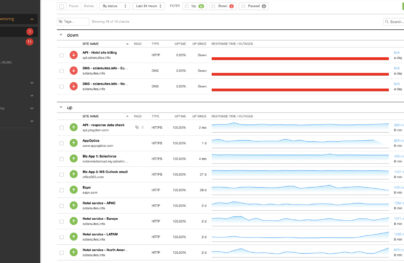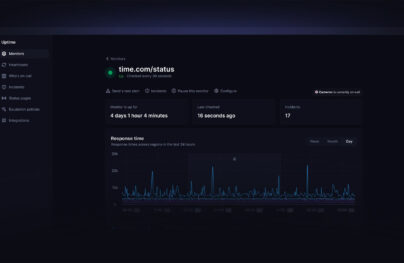How to Improve Customer Relationships with Website Intelligence, Status Pages, Incidents Reporting
Websites are undoubtedly the cornerstone (or corner store) of online businesses. The technology used to monitor, understand, and optimize their performance, however, has been rather stagnant until more recently.
The emergence of Website Intelligence is seeking to put an end to that and support digital companies in building better relationships with their customers.
A Fragmented Market
So, if websites are so important, why has analytics technology been so labored in its development?
In short, Google Analytics.
Close to three-quarters (74%) of the internet’s 10,000 most popular websites are currently using Google Analytics (BuiltWith). And, in total, over 28 million sites rely on analytics from the US tech giant.
To such an extent have they been able to monopolize the market, it was almost taken for granted, for many years, that this was the only way to do things.
With Postcards Email Builder you can create and edit email templates online without any coding skills! Includes more than 100 components to help you create custom emails templates faster than ever before.
Free Email BuilderFree Email TemplatesAs with all monopolistic industries, however, this came with a range of drawbacks – from poor UX to the limited development of new features.
Indeed, the overly complex platform was almost a constant gripe in every marketing department. And the quite flawed solution was simply for most medium-to-large marketing teams to have an analytics specialist as part of their team.
Though this may seem quite logical, it resulted in a range of issues, with most marketers becoming overly reliant on such specialists, as well as the creation of a disconnect between the data gathering process and the formulation of insights.
It doesn’t take a genius, however, to recognize the opportunity for new solutions in this arena. And as the martech scene exploded, finally website analytics started to evolve away from its archaic roots.
Though this has seen the emergence of many vastly more engaging, visual, and user-friendly platforms, it has also resulted in an overabundance of such solutions and an almost patchwork approach to holistic information.
And, it should be quite apparent to most that the words “patchwork” and “data” don’t tend to go well together.
So, why has this happened?
The answer is quite simply that many of the new emerging companies have seen themselves as supplementary to Google Analytics, as opposed to an alternative to.
With Startup App and Slides App you can build unlimited websites using the online website editor which includes ready-made designed and coded elements, templates and themes.
Try Startup App Try Slides AppOther ProductsThough this doesn’t solve the issues around UX and data exclusivity, it does address the issue of labored feature development and inject some life into the sector.
Marketers want more than pretty charts and vanity metrics, however, and so more often than not these new technologies have resulted in greater complexity, rather than less, and have required the marrying of even more segmented datasets.
To give a more concrete example, heatmaps and session recordings have been hugely popular new features within the website analytics sector. The majority of such solutions offer very little by themselves, however, and marketers are forced to combine visual insights from these platforms with analytical data from elsewhere. For those that don’t, the benefits are minimal.
So, how is this fragmentation issue solved?
Entering the Era of Website Intelligence
As sectors evolve and broaden, slowly but surely they become redefined. And that is what’s happening with this shift from Website Analytics to Website Intelligence.
As mentioned above, the website analytics sector has been developing a range of new features over the past few years – but in a fragmented manner. As this evolutionary phase has advanced, what has started to form is very clear groupings – or pillars, as we call them. Website intelligence is built upon this tri-pillared foundation.
So, what are the three pillars?
Pillar 1: Performance Statistics
This is all that existed prior to the last few years and is what many marketers may still understand as being representative of the website analytics sector as a whole.
Performance statistics includes all the data that you need to analyze, in a quantifiable sense, how well your website is performing.
How many people are visiting your website? How many of them are doing so for the first time? What pages are they entering into your website? What channels are they coming from? Where are they going next?
These statistics enable you to assess the popularity of your website over time; the appeal of your messaging, product, offers etc.; the success of various campaigns and channels, and many other things.

Pillar 2: User Behavior
It is no secret that User Experience (UX) has become increasingly important in all aspects of our lives, but especially the digital world, as the competitive landscape has become ever more vast.
Quite simply, it’s the experiences that users have with technology that act as precursors for success or failure.
People are less patient, have greater expectations, and can access a much more varied selection of options in almost every area of their lives.
Think about your own experiences. Ever looked to make a purchase from a website or sign up for a platform, only to give up and exit the page after struggling with certain steps of the journey? And, after how long?
According to research, our attention span has markedly decreased in just 15 years. In 2000, it was 12 seconds. Now, 15 years later, it’s shrunk significantly to 8.25 seconds. So, it only takes a few bumps in the road to turn users off completely.
So, with that said, the User Behavior pillar of website intelligence enables users to access a more true-to-life, visual, and human visualization of how their website visitors are experiencing their website.
This can be absolutely crucial for identifying blocking points, areas of confusion (or cognitive challenge), and even performance issues.
For example, if a landing page is converting less than expected, session recordings can provide great insight as to where users may be encountering problems. It could be that the defined rules for a set field are creating multiple error results; certain fields require too much thought or external input, or quite simply there is an issue with the forms and they’re not submitting.
Heatmaps also break down general performance statistics in a much more visual way, enabling us – within a single view – to observe which areas of our websites are getting the most attention (be that through clicks, hovers, or scrolls).
Both of these two User Behavior features – session recordings and heatmaps – can be used as the starting point to gain new insights (to later be further blacked up by quantifiable data) or alternatively can be used to add additional insight to existing data-derived assumptions.
It should not go unsaid too that such features are themselves much easier and enjoyable to use, and are accessible to far more people than complex analytics. Equally, they offer a greater variety of illustration in which to compose narratives for agency clients, C-suite, and other team members.
Additional features in this pillar also include conversion funnels and custom event tracking, which enable you to better understand successful user journeys and campaign performance.
Pillar 3: Visitor Communication
Gone are the days of waiting several days for email feedback when encountering issues with products or services (or at least this is increasingly the case).
In line with what is mentioned above regarding attention spans, these days we also have much less patience when it comes to seeking answers to our questions or solutions to our issues.
This has been the driving force behind the huge increase in chatbot utilization in recent years, with AI also enabling the creation of vastly improved automated offerings in this area.
This is only one aspect of communication, however, with surveys and polls also being hugely popular features. These enable more direct feedback from users, with regards their experiences, and also increase the level of engagement, and therefore sense of community, between product/website owners and their user base.
So, in summary, the visitor communication pillar of Website Intelligence is used to enhance support, gather feedback, and increase community engagement. This direct feedback, married with data and insight from the other two pillars, can be key in enhancing user experience, customer satisfaction, and reducing churn.

Why is Website Intelligence so Important?
The experience people have on your website, and its performance relative to this, is fundamentally the make or break of any digital business.
It’s most likely that I’d be preaching to the converted if I were to evangelize why website optimization is so important, and thus instead I’ll focus on why this more centralized, holistic, defragmented approach carries huge benefits.
Firstly, as has been a repetitive topic in this article, humans quite simply have less focus these days. And that goes for us marketers too.
In fact, more than most, we are exposed on a daily basis to a wide range of digital touchpoints. And this can quite quickly, without appropriate care, translate into digital fatigue or even burnout.
One key cause of such issues is the quantity of technology that we have to deal with on a daily basis. It is not uncommon for marketers to be jumping between 10 or more platforms throughout the course of a day.
When you consider that for Website Intelligence alone, marketers may be using more than five platforms, you can start to see the issue.
Of course, it goes beyond mere usability too. We discussed patchwork data earlier in the article. Not only does it take more time to gain real insights if all website intelligence features are scattered across different platforms, but too it can result in less accurate insights – with the data across each platform varying somehow (something that is incredibly common).
Another part of the issue, which again touches more upon the human/user side, is the process of onboarding new technology. With so much tech now running throughout the various departments of digital companies, successful onboarding processes is absolutely essential.
Even prior to this crucial onboarding step, there is the complex solution identification and procurement process to consider. But, once that has been completed, and a license has been purchased, it’s vital that the tech is utilized to as great a degree as possible. It’s becoming far too common to have dormant technology creating budget drain and too have other expensive solutions being used only for their most basic features.
By having access to all of these website intelligence features in one centralized place, you solve all of these issues. You limit the number of procurement processes required for a singular use case, ease onboarding and adoption, and enable users to gain better insights, faster.
It is also, of course, far more cost-effective – with many companies charging a premium for only very limited features.
As a final point, having one centralized platform to understand and optimize our website would also enable you to play a role in the evolution of this new sector. As mentioned in the “Pillar 3: Visitor Communication” section above, by actively being part of this engaged community, you will be able – through feedback – be able to help shape improvements in the future.
And, of course, all of this has an end goal of improving relationships with your customers – through more user-friendly websites, clearer user journeys, optimized messaging, active community engagement, and direct communicative support.
What About Data Privacy?

When talking about customer relationships, it is of course imperative to discuss trust – and, well, that means data privacy.
Alongside the overwhelm, attention span massacre, and data chaos (it’s not really that bad), the rapid growth of the digital age has also led to more concerns regarding our personal data.
Social media has had a major role to play in this, when it comes to issues around fake news, hacks, and other digital wellbeing concerns. However, it is websites where we tend to part with some of our most valuable personal data.
The issue around data privacy has, of course, grown in prominence over the past few years, with 2018’s GDPR acting as a key milestone in this respect.
This year especially, the impact of GDPR on website owners – and indeed their users – has created somewhat of a sudden reality check regarding how far away we are from attaining a healthy place with regards data privacy.
Marketers have – or, at least, should have – had a rude awakening with regards to the digital marketing tech they are utilizing to reach more prospects, nurture said prospects, and better understand their user base.
To put this into perspective, Google Analytics has been banned in certain EU countries, while others have suggested that companies should find data storage and web analytics solutions that don’t transfer data outside the Union.
There has also been a sizable increase in GDPR-related fines over the last couple of years, with
Amazon leading the way – having been fined €746 million for breaches related to cookie consent. Other huge fines have also been handed out to Whatsapp, Google, and Facebook.
It’s not just big tech companies who face GDPR-related fines, however, with the smallest fine to date being just €28 – dished out for “non-compliance with general data processing principles”.
So, how is it possible to utilize all of the above mentioned features, while still remaining GDPR compliant?
In short, with Visitor Analytics. Again, the beauty and benefit of a centralized platform is that your DPO doesn’t have to deep dive into compliance for a range of different solutions. Instead, they can approve just one and still provide you with all the features you need.
In a recent independent privacy audit by PrivacyBoard, we were rated the only privacy-perfect website analytics solution – scoring 100 out of 100 in the audit.
There are a number of things that contribute towards this, but fundamentally everything comes down to privacy by design and the fact that our technology has been developed with privacy at its core since the very beginning.
This has resulted in a unique fingerprinting approach to obtaining data and means that our platform requires zero cookies – and, therefore, zero cookie banners.
To give a simple overview, our platform doesn’t tie data to an individual or access anyone’s device; we don’t track users beyond your website, and we don’t attach their behavior to personal data (such as name or email address). .
Beyond trust and ethics, one other key benefit of this approach is that – in lieu of cookie consent banners – we are able to enable you to gain data, and therefore insight, from 100% of your website visitors – not the circa 5% that opt in when requested.
This is, of course, crucial in gaining true insights that enable you to understand better, and accommodate more for all users of your website.
Supplementing Website Intelligence with Incidents Reporting & Status Pages
While website intelligence focuses on the UX, messaging, and experience of your website, there are also additional, more technical, issues that can also impact how customers experience – and feel about – your website.
Though website intelligence can help you to spot technical glitches – such as a non-operational form or page loading error, it’s also crucial to ensure that any outages or technical glitches are spotted and addressed immediately.
As most marketers would attest to, websites – and their back-end – tend to have a life of their own sometime. And they have a tendency to inexplicably falter.
Such issues can also, of course, have an impact on user experience. How long would you continue to trust a website if once or twice you encountered some sort of error? Again, it comes down to patience and attention span – that dopamine hit ain’t gonna wait for nobody.
Especially, if you are working with a high traffic, high converting website, where even an hour;s downage can result in a huge loss of revenue, you need to keep ahead of the glitches.

This is where Incidents Reporting and Status Pages come in.
G2 reviewers have awarded Pulsetic an impressive 4.8-star rating, highlighting its standout performance in comparison to its competitors.
Though very different – in terms of use case and features – to the three pillars of website intelligence, such solutions provide a great supplementary product to enhance further how customers experience your website – and to build trust.
Incident Reporting is nothing new; it’s simply that its appeal and benefits are now extending beyond the early (and long-term) adopters – such as healthcare and aviation – and appealing to many more sectors and industries.
This is simply because, as touched upon above, technical issues with websites can now have a much fiercer and more abrupt impact on a broader range of online businesses. The speed of transactions is faster and the amount of money being spent online is much higher – we simply can’t afford technical issues any more.
In simple terms, Incident Reporting is an automated method of receiving alerts and reports based on a website’s technical performance. Such triggers can result in immediate manual attention from IT, development, and/or marketing departments.
If it sounds like it may be a little too technical for your purposes, be rest assured that the appeal of the solution to a wide range of sectors has led to an evolution in its UX too. In other words, it’s been tailored for use by non-technical people and, therefore – much like website intelligence – is something that any revenue-generating website can benefit from.
Status pages are one key feature in this respect, providing an overview of a website’s health – which can be publicly available or for internal purposes only.
The key benefit of this, aside from being able to address any issues in a much more efficient manner, is again related to that key word – Trust.
By being open and transparent – both internally and externally – there is much greater cohesion between your company and your customers, as well as your various internal departments This helps to remove confusion and frustration, and enables those responsible for providing assistance to do so in an optimal manner.
Pulsetic is one such company to offer a solution in this area, with different offerings for start-ups, more established digital businesses, e-commerce, and developers, and with alerts sent by phone call, SMS, email, or Slack.
The product also comes with a range of additional features, including localization (i.e. identifying where such outages are occurring, if not global), SSL certificate monitoring, and attention to visual appeal with regards to public status pages.
Treat Your Website Like You Would a Physical Store
By combining Website Intelligence with Incident Reporting and Status Pages, you are able to ensure that your digital shop front is always how you want it; your in-store experience is pleasant; and your customers leave happy (and come back).
Of course, all digital businesses take care to make sure that their website looks good, and there are plenty of great platforms to support this process. However, the overall functionality and experience can be somewhat overlooked.
This is not surprising, considering how complex it can seem to stay on top of all such activities. However, by centralizing multiple features and opting for accessible products, you are able to quite quickly get onboarded and keep one step ahead of your competition.
Whether an established online business or a start-up, the impact and importance of taking such steps shouldn’t be underestimated. By treating your website with the care and attention you would a physical store, you will be able to attract and retain a much larger volume of valuable customers.
And, beyond this, by taking such steps, you are also able to improve the experience of those responsible for managing, maintaining, and optimizing your website. And nothing will carry more benefit to your company than a happy internal team.







